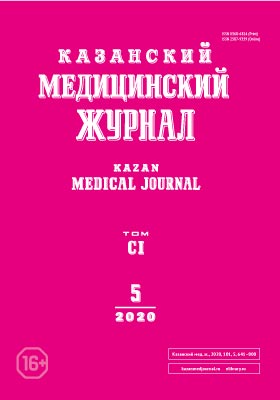Результаты перинатального аудита Северо-Западного федерального округа
- Авторы: Иванов Д.О.1, Шевцова К.Г.1, Моисеева К.Е.1, Харбедия Ш.Д.1
-
Учреждения:
- Санкт-Петербургский государственный педиатрический медицинский университет
- Выпуск: Том 101, № 5 (2020)
- Страницы: 727-733
- Раздел: Социальная гигиена и организация здравоохранения
- Статья получена: 25.08.2020
- Статья одобрена: 15.09.2020
- Статья опубликована: 27.10.2020
- URL: https://kazanmedjournal.ru/kazanmedj/article/view/43125
- DOI: https://doi.org/10.17816/KMJ2020-727
- ID: 43125
Цитировать
Аннотация
Цель. Оценить результаты перинатального аудита Северо-Западного федерального округа и выявить резерв снижения перинатальных потерь.
Методы. Аудит перинатальных потерь проводили в два этапа: (1) удалённый аудит — аудит показателей перинатальной смертности; (2) очный аудит — аудит случаев перинатальной смерти ребёнка на основе медицинской документации. Проведена выкопировка данных из 925 медицинских документов на 220 случаев перинатальной смерти. В перинатальном аудите Северо-Западного федерального округа применяли Скандинавско-Балтийскую классификацию перинатальных потерь. При статистической обработке данных использовали следующие статистические методы: частоту признака определяли при помощи частотных таблиц, достоверность значимости различий между качественными признаками проверяли при помощи таблиц сопряжённости с использованием критерия χ2 наряду с коэффициентом корреляции Пирсона. Оценку значимости различий количественных показателей проводили при помощи t-критерия Стьюдента. Уровень значимости был установлен как р <0,05.
Результаты. Установлено, что в Северо-Западном федеральном округе антенатальные потери (III категория Скандинавско-Балтийской классификации — дети гестационного возраста более 28 нед без врождённых пороков и задержки внутриутробного развития) составляют 27,5%, интранатальные потери (VI категория, дети гестационного возраста более 28 нед без врождённых пороков и задержки внутриутробного развития) — 7,4%, потери новорождённых (VIII–XI категория — дети гестационного возраста более 28 нед без врождённых пороков и задержки внутриутробного развития) — 16,9%. Среди детей, умерших в перинатальный период, статистически значимо преобладают дети гестационного возраста более 28 нед (р=0,003). В нозологической структуре мертворождаемости бо́льшую часть составляют заболевания, связанные с дыхательными нарушениями (85,9%), на долю инфекционных осложнений приходится 14,1%. Основными причинами смерти новорождённых в ранний неонатальный период становятся респираторные нарушения (40,0%) и инфекционные болезни, специфичные для перинатального периода (36,0%). Оценка половых особенностей антенатальных потерь не выявила статистически значимой разницы (р=0,29). Оценка половых особенностей интранатальных потерь показала, что достоверно преобладают мальчики (р=0,003).
Вывод. Проведённый перинатальный аудит выявил, что в Северо-Западном федеральном округе уровень мобильного резерва перинатальной смертности, связанного с управляемыми причинами, составляет 51,8%.
Полный текст
Об авторах
Дмитрий Олегович Иванов
Санкт-Петербургский государственный педиатрический медицинский университет
Email: audit-line1@yandex.ru
Россия, г. Санкт-Петербург, Россия
Ксения Георгиевна Шевцова
Санкт-Петербургский государственный педиатрический медицинский университет
Автор, ответственный за переписку.
Email: audit-line1@yandex.ru
Россия, г. Санкт-Петербург, Россия
Карина Евгеньевна Моисеева
Санкт-Петербургский государственный педиатрический медицинский университет
Email: audit-line1@yandex.ru
Россия, г. Санкт-Петербург, Россия
Шалва Демнаевич Харбедия
Санкт-Петербургский государственный педиатрический медицинский университет
Email: audit-line1@yandex.ru
Россия, г. Санкт-Петербург, Россия
Список литературы
- Иванов Д.О. Руководство по перинатологии. СПб.: Информнавигатор. 2019; 1519 с.
- Александрович Ю.С., Паршин Е.В., Пшениснов К.В. Прогнозирование ранних исходов критических состояний у новорождённых. Вестн. анестезиол. и реаниматол. 2012; 9 (4): 36–42.
- Баранов А.А., Альбицкий В.Ю. Смертность детского населения России (тенденции, причины и пути их снижения). М.: Союз педиатров России. 2009; 387 с.
- Харбедия Ш.Д. Стандартизация и статистический учёт в здравоохранении. СПб.: Сотис-Мед. 2018; 228 с.
- Кулаков В.И., Вихляева В.М. Перинатальный аудит при преждевременных родах. М.: Водолей. 2005; 223 с.
- Давыденко Н.Б., Татарева С.В., Николаева Е.Б., Малямова Л.Н. О совершенствовании оказания перинатальной помощи матерям и детям в Свердловской области. Уральский мед. ж. 2011; (12): 5–9.
- Девятова Е.О., Литвинова А.М. Предотвратимые и непредотвратимые причины смерти новорождённых в УрФО. Уральский мед. ж. 2011; (7): 52–55.
- Литвинова А.М., Девятова Е.О., Давыденко Н.Б. Профилактика младенческой смертности в УрФО на основе сокращения предотвратимых причин смерти. Вестн. Уральской мед. акад. науки. 2009; (4): 36–38.
- Основные показатели здоровья матери и ребёнка, деятельность службы охраны детства и родовспоможения в Российской Федерации в 2018 году. Электрон. статист. сб. http://mednet.ru/images/stories/files/static/zdorovie_materi_i_rebenka_2018.doc (дата обращения: 22.06.2020).
- Кравченко Е.Н., Кривчик Г.В. Оценка перинатальных потерь в крупном регионе Западной Сибири. Журнал РОАГ. 2007; (3): 24–26.
Дополнительные файлы







